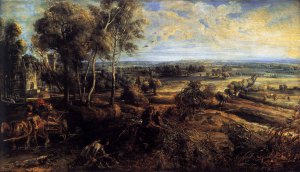Twelfth Approach to Het Steen, 1636

Peter Paul Rubens: 'A View of Het Steen in the Early Morning', 1636. Oil on Oak. Oil on oak.131 x 229.cm. National Gallery, London
http://www.nationalgallery.org.uk/paintings/peter-paul-rubens-a-view-of-het-steen-in-the-early-morning
Het Steen
At the National Gallery for a brief moment.
Looking at this painting very closely, what intrigues is the evident process; stages shown not hidden under seamless layers of glazes. Rubens laid in thick white last, probably Cremnitz White, ie Lead White ground with Walnut Oil rather than Linseed Oil to stop yellowing with age. Lead Whites were extremely poisonous, traditionally used for underpaint, stiffer and drier than Flake White which has a bit of Zinc in it. Certainly these laid in areas are thicker and show the brush, possibly palette knife, that laid on the impasto.
He then washed in a translucent glaze of a drab yellow around the trees in the grown out hedge going from the centre foreground off to the right for example. Or, a reddish brown on the overlaid impasto around the overgrown fruit tree centre foreground. The function of these rough, lighter areas is to provide depth and background behind brambles and trees, to foreground them.
What is odd, is the inaccuracy of this foregrounding, it is not characteristic bravura and Rubensian vigour. These are great horizontal streaks that go right over very carefully painted passages; roughly delineating the oversized fowl for example. That central tree is painted in detail and with enormous care, it is probably taken from, what looks an en plein air, drawing made in 1616 of a Wild Cherry Tree with Brambles and Weeds
The Courtauld Institute, London, although they call it ‘a Study of Blackthorn with Bramble and other Plants’, unlike Christopher Brown in the National Gallery’s ‘Making and Meaning Ruben’s Landscapes’ who goes for the Cherry Tree appellation).
It is as though Rubens had given the task of foregrounding this tree to an untrained, but enthusiastic child. It reminds me of my own attempts, when very young, to help my father with one of his own paintings. My thick muddy brushstrokes lapped around his careful shapes; the leg of a dog against a white background. This painting hung as a personal reproach on a wall in our house for most of my childhood.
When you look closely, the whole of Het Steen is marked by unevenness, small thick autonomous impasto on the left, the windows, the horses tack. Or, beautifully painted thistles amongst rough brown splashes. Or, extreme differences of scale; the vast fowl and cows as big as trees – why?
It is Friday evening, late opening. An elderly couple, white, very English, rather proper in beige linen are very asleep on the bench in front of Het Steen. Next to them a large Asian family are really enjoying a worksheet on the painting: how many cows; can you spot the man fishing; what is on the cart? Dad engages with great vigour, then sneaks in a quick phone call whilst the attendant is not looking. Troops of Russians march past, it is too late in the day for the huge coach parties of unattended European schoolchildren.
